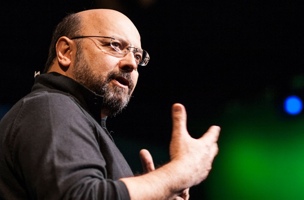Gallo giving a TED talk. Image source: TED
In advance of this year’s International LiDAR Mapping Forum in Denver, we caught up with keynote speaker Dave Gallo. Gallo is perhaps best known for his extremely popular TED Talks and his work co-leading an expedition to create the first comprehensive map of the RMS Titanic, but he spends his days working as the Director of Special Projects with the Woods Hole Oceanagraphic Institution.
We covered the basic challenges of undersea mapping, the weirdness of matching sonar and photography, and the incredible value of LiDAR.
(This interview has been edited for clarity and length)
SPAR: For those who don’t know you, could you give a quick background explanation of who you are and what you do?
Dave Gallo: I’m an oceanographer, and I got my master’s and my PhD mapping the sea floor. My master’s was mapping the mid-ocean ridge, which is this 50,000-mile-long underwater mountain range. After my PhD, I came to Woods Hole, where I started working with robots and cameras with Bob Ballard, who had just discovered the Titanic. After working with his group for about five years, I went to do the same things I was doing with Ballard for the whole institution as Director of Special Projects.
This allowed me to dabble in technology, but also brought me back to the sciences where we use that technology in ways that scientists usually don’t: for shipwrecks, planes, aircraft, and stuff like that.
SPAR: Can you give me a sense for what you’re presenting during your keynote?
Gallo: I plan to lay out the deep sea issues—what’s different about mapping it. You can’t use GPS, you can’t use radio communications. We have to build our own systems, as well as our own sensors and platforms.
It used to be that we would take a photo and didn’t know where it came from within more than 10 miles and had a very blurry idea of what we were looking at. Now, we’ve progressed to the point where we’re doing mosaics on the sea floor, hundreds of meters by hundreds of meters or even more than that. We’re taking thousands of photos.
In the case of Air France [which Gallo assisted in locating]we took 85,000 photos and made it into one single mosaic. The Titanic was the same thing, we took thousands of pictures and created one mosaic.
SPAR: But there are still problems, of course. The technology isn’t quite there yet, right?
Gallo: I’ll show some pictures of Titanic, which are state of the art, and they look fantastic. But we still have the issue of matching the acoustic information—sonar, how tall something is, how wide something is, how far off the bottom—with the optics, which is much higher resolution.
When you take these extremely high resolution videos—we’re shooting in 8K now—and lay it down on sonar and it looks terrible, because the diffusion’s not there. But we’re working on it.
That’s also where LiDAR comes in, by the way. It removes the ambiguity when you have to merge optical data with sonar. It gives you one more step toward bringing the two together.
SPAR: It seems like LiDAR would be hugely useful to oceanographers.
Gallo: I think you’re right. For instance, we were just involved in mapping the battlefield of Normandy offshore, where so many ships sank and men and women lost their lives, and we always have this gap between the fairly deep water and the shoreline. I hate it. I hate it with a passion, because I think what we need is continuity. I tried to get them to use LiDAR then.
The meeting I’m going to after this interview is about mapping in the Medditeranean, where we’re looking at all these ancient civilizations. A lot of them have roads that have fallen into the water because the cities have sunk. There, too, instead of having these funny gaps, LiDAR would give us continuity.
And I’m not doing it for my sake, I’m doing it for the sake of the viewer, so they don’t say “Why is that missing? What is the funny looking black splat on the screen?” I think it’s important to fill in all those points. I look at the LiDAR stuff, the mapping of rain forests that’s coming out of climate research, and it’s self-explanatory. I mean, what more could you want?
Catch Dave Gallo’s keynote at the 2016 International LiDAR Mapping Forum, February 22-24 in Denver CO.






